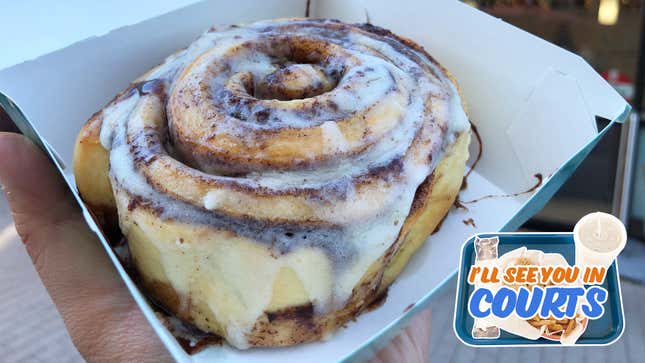
Welcome to I’ll See You In Courts, a semi-regular meditation on food court cuisine.
Existential question time: When has man truly desired a cinnamon roll? What are the circumstances that lead one down the neurologic garden path that ends with a warm cinnamon roll in hand? Come up with 50 foods to crave and a cinnamon roll would appear nowhere near. A fresh-baked cinnamon roll by itself is good, but it’s not that good. It needs a marketing team.
Enter Cinnabon—the longtime food court stalwart with more than 600 locations worldwide—which realized cinnamon rolls weren’t just about the end product. The Cinnabon experience is a ritual and a narrative. It needs the exposition to get to the payoff.
Do you remember the first time you ever saw a pastry chef in action? I don’t, but I do remember going to the mall food court and watching Cinnabon employees hand-rolling dough behind the glass counter. Every mall-goer has spent at least 30 seconds transfixed by this ceremony, a performance that shows Cinnabon’s mastery of food-as-theater. A single, wide sheet of impossibly smooth dough gets smeared with soft butter, then every square inch is covered with powdered cinnamon. A comically large rolling pin gives it a once-over, and the whole sheet is rolled into a log, cut at equidistance, revealing a satisfying and perfect Fibonacci spiral.
When the cinnamon rolls emerge from the oven, they’re golden and crusty along the edges. More satisfaction: Cream cheese frosting is spackled atop the exposed spiral, the buttery paste collapsing from the warmth, melting into crevices, gooefying. When a roll gets separated from the Cinnabon grid, liquid laces of cinnamon-sugar drip seductively. The sight of this is enough for most mall-goers, no purchase necessary. But then, once in a rare while, the conditions are right, the stars align, and suddenly you find yourself being lead down the neurologic garden path. You can’t explain how, but you end up with a warm cinnamon roll in hand.
Does one ever suddenly demand a cinnamon roll? One needs to be nudged in that direction. And when you watch this song and dance, something inside you obliges. It’s a triggering event. I remember reading once how Wolfgang Amadeus Mozart woke up in the morning: A servant would play a scale on the piano, but purposely leave out the last note. The scale not resolving itself would drive Mozart to madness, clawing at his psyche, until he leapt from his bed and rushed to his piano, playing the last note and completing the scale to his relief.
I’m pretty sure that’s how Cinnabon suckers you in.
The roll itself is a fork and knife dish. It is heavy and unwieldy, never to be consumed by one person in one sitting (a classic roll with the added frosting cup contains 1,090 calories). Some claim the center point of the roll is best, but I disagree. The texture there is too soft, resembling bread pudding. I’m of the philosophy that as you stray from the outer spiral, it’s diminishing returns. Crisp is best, and crisp is outside. An ideal bite consists of teasing out a single layer of the brioche-like crumb from the outside inward, gently unraveling from itself, until a matchbook-sized piece is procured. There should be that golden hue of melted butter incorporated into the baked dough, paint-brushed with the sticky mingle of cinnamon and butter-cream cheese frosting.
That, right there, is the denouement. It is the climax of the Cinnabon tale. You watched it born from nothing—dough, butter, cinnamon transformed by heat and chemistry into a classic American pastry. You witnessed the pornography of frosting application. All that dripping. The goo and the sweetness. By itself, a cinnamon roll is an obscenity. With the proper context, it scratches an unreachable itch.